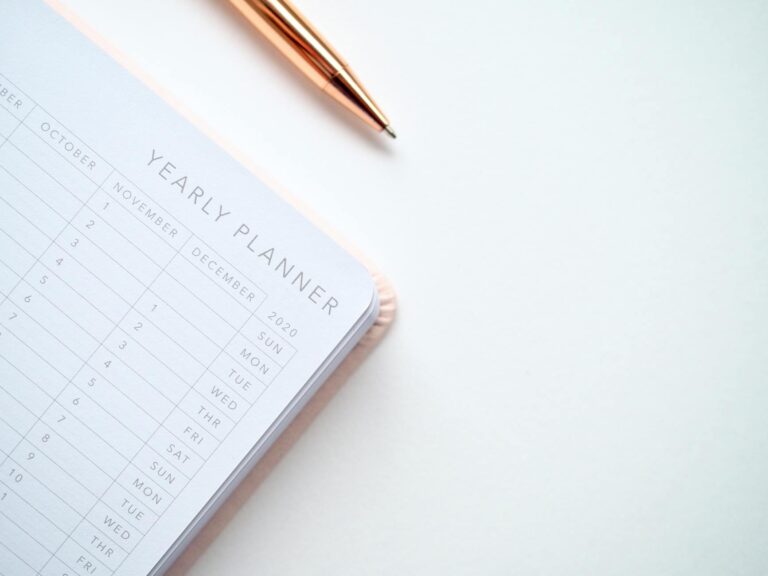
The Key to Improving Your Time Management
When you’re trying to juggle your work-life balance, time management can quickly go out the window. However, you can reign it back in with the help of a time study.
What is a Time Study?
The name is self-explanatory, you can use a time study to figure out where your time goes during the day. It can also help discover toxic habits (how many times did you browse TikTok today?), create boundaries between work and home (no checking emails while cooking dinner), and refocus your efforts in the right direction.
The key to a time study is taking down your activity every fifteen minutes. That way, you have a clear idea of how you spend your time during the day and can adjust accordingly.
Time Study Template
Some people like using an app or other time-tracking software to keep track of their time study, but I prefer the pen-and-paper method.
Something about the feel of the paper and the way my brain works to write the words makes it more realistic to me. However, I know that you may not know where to begin with a paper time study, so I created a template for you.
All you have to do is print it out and fill it in. Easy peasy!
Using the Template
Before we begin, let’s talk about commitment. If you want to figure out where you’re spending your time, you’re going to need more information than a single day can give.
I recommend picking a workweek where you’re focused on work, not worrying about traveling or the kid’s hockey tourney- just a typical bread-and-butter workweek.
Once you have your week picked out, print out five copies of the template for each day- Monday through Friday and at least one day on the weekend- and put them somewhere noticeable.
Then, you’ll want to begin tracking your time from the moment you wake up. The general rule is to write down your activity every 15 minutes. You could also mark the time whenever you begin a new task. Personally, I’d do both.
Here’s an example:
Let’s say you wake up at 6:30 a.m. You yawn, stretch, and go to the bathroom. Fifteen minutes later, you mark that you’re brushing your teeth and getting dressed. Fifteen minutes after that, you’re making the bed, and then you mark the time because you’ve finished the bed and started making coffee before those fifteen minutes are up.
Get it? You want to record every fifteen minutes or whenever you switch to a new task. That way, you can get a more accurate look at your time management.
Using Categories
Once you finish recording your activities for the day, it’s time to categorize them.
Go through your list and mark them as Family Time (spending time with your kids, partner, parents, or friends) Life (making dinner, commuting, driving to sports, etc.) Work (working in or on your business – it helps if you get into the nitty-gritty of what you’re doing admin vs marketing, etc.) Screens (social media, scrolling TikTok, watching TV, etc.). At the end of the day calculate how much time you’re spending in each category.
How much time do you spend with family? How long do you do household chores every day? How many hours have you spent on social media?
Once you’ve found the category with the most time spent, you can find a way to refocus that energy into your business.
On a side note, everyone’s time study looks different, so don’t worry if your work category surpasses your family or friend category. Everyone had to begin somewhere, and you can even it out later.
Time Study Reflections
When your five days are up, take your carefully mapped-out sheets and spread them out. Review the numbers, reflect on their meanings, and then find ONE category to change for the month.
For example, let’s say you spend four hours on social media every day. That’s a lot of wasted hours, so you pick that category and create a plan to lower the numbers. You try it for a month, then do another time study and see what it says. I have a helpful social cleanse series on my Instagram that shows how to kick that nasty screen habit and be more present.
If your plan worked, pick the next category to work on. If it didn’t work, adjust and try again.
By the way, you don’t have to do a time study cycle every month. Just enough to shrink the problem areas and keep from feeling overwhelmed, lost, or clogged in your time management.
(However, if you want to keep going month-to-month and optimizing your time, that’s OK too, Do what works for you)
Final Thoughts
A time study is a wake-up call for most people, and it can help you make small changes that boost your time management and cut out any toxic habits you may have.
A time study can help you figure out your time habits, fix problem areas, and turn your time management into an efficient machine.
All you need is a pen, a sense of commitment, and the template below.



Pin This Post




Meet Bai-Leigh
OBM & Systems Strategist
It’s time to strategize, scale, and skyrocket with systems. I’ve made it my mission to help simplify and streamline online businesses using the best systems and processes for you, the business owner.
I have helped over 100+ businesses scale their business using efficient and repeatable systems so that they can continue with their zone of genius while I take care of the rest.
From processes, systems, efficiencies, and automations – I do it all. If you’re looking for a strategic partner then you’ve come to the right place.
Interested in getting started? You can book a FREE Discovery Call below!

Client Onboarding Checklist
Provide your client with an automated and seamless experience – every time with this Client Onboarding checklist.
It covers all of the basic parts of onboarding and a few pieces to make onboarding stand out.
If you want to have clients buzzing about your onboarding you need this checklist.
Recent Posts


Budget Friendly Ideas for Generating Leads

How to Find and Solve Bottlenecks in Your Processes
Related Posts

How to Make Time for Your Processes
Time to prioritize your processes, shave hours off your schedule, and set your business up for success in no time.

5 Different Ways to Manage Your Time
There are several ways to manage your time more effectively. To get you started, here are five of my favorites.


